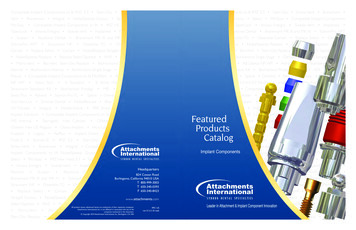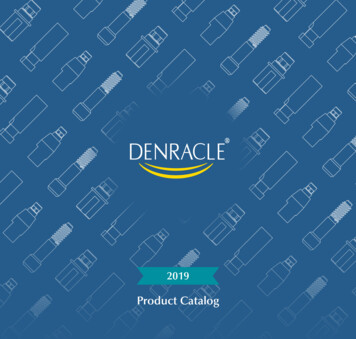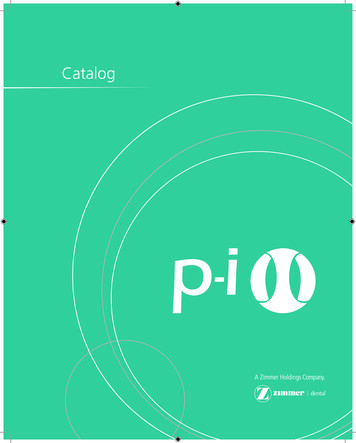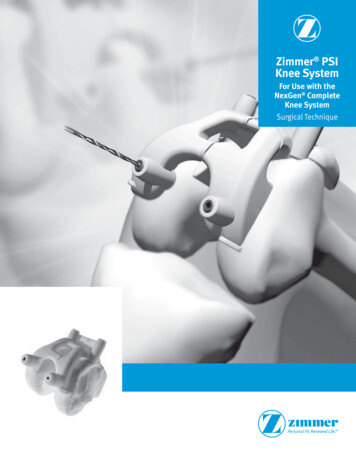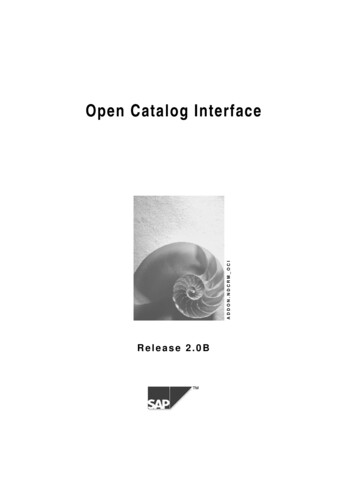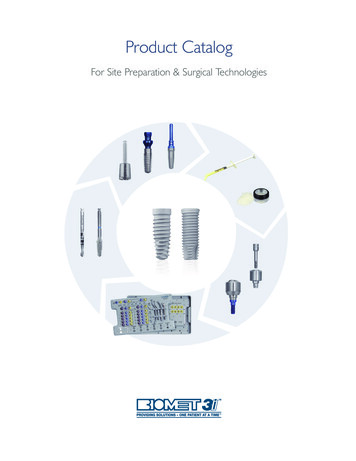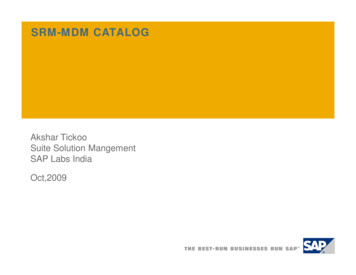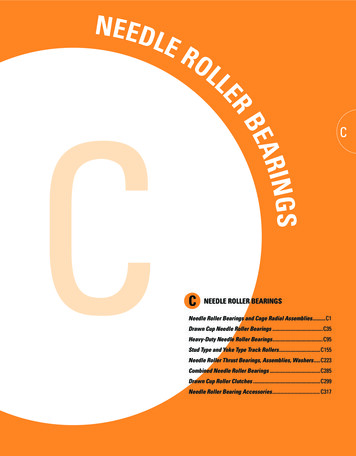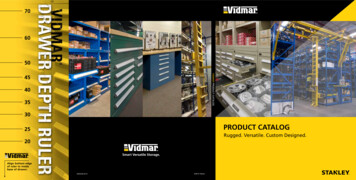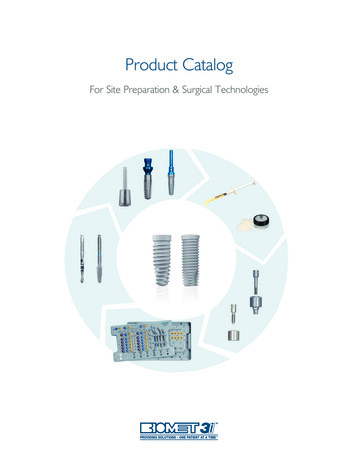
Transcription
Product CatalogFor Site Preparation & Surgical Technologies
Table Of ContentsIntroductionCompany OverviewImplant & Abutment System ConnectionsImplant Body & Connection TypesCertain Platform Switching ImplantsSurface TechnologiesThe T3 Implant FamilyThe NanoTite Implant FamilyThe OSSEOTITE Implant FamilyTop-Down Treatment PlanningCertain Internal Connection ImplantsT3 Tapered With DCD Platform SwitchedT3 Tapered With DCD Non-Platform SwitchedT3 Tapered Platform SwitchedT3 Tapered Non-Platform SwitchedNanoTite Tapered Certain PREVAIL NanoTite Tapered CertainFull OSSEOTITE Tapered CertainOSSEOTITE Tapered Certain PrevailT3 Parallel Walled With DCD Platform SwitchedT3 Parallel Walled With DCD Non-Platform SwitchedT3 Parallel Walled Platform SwitchedT3 Parallel Walled Non-Platform SwitchedOSSEOTITE 2 Parallel Walled CertainExternal Hex Connection ImplantsT3 Tapered With DCDT3 TaperedFull OSSEOTITE TaperedOSSEOTITE TaperedT3 Parallel Walled With DCDT3 Parallel WalledOSSEOTITE 2 Parallel WalledFull OSSEOTITE Parallel WalledOSSEOTITE Parallel Wallediiiivvviviiviiviii1111223344444BellaTek Encode Two-PieceEP One-Piece External Hex ConnectionBellaTek Encode Two-PieceEP One-PieceProduct OverviewTapered Navigator System For Guided SurgeryParallel Walled Navigator System For Guided SurgeryTapered Implant Surgical KitsParallel Walled Surgical KitsW & H Surgical Drilling UnitACT Non-Irrigated Reusable Twist DrillsSurgical DrillsDrills, Quad Shaping Drills For Tapered ImplantsSurgical ComponentsHandpiece Bone ProfilersLow Profile Abutment Bone ProfilersCertain Manual Bone ProfilersBone Profiler Guide PinsBone Profiler Organizers & KitsBone Taps, Dense Bone Taps For Tapered ImplantsDepth/Direction Indicators For Tapered Implants,Direction Indicators, MountsMiscellaneous InstrumentationSite Preparation ComponentsStraight And Angled OsteotomesSummer OsteotomesSinus ElevationTrephine rative Technologies556677788Healing AbutmentsCertain Internal ConnectionSite Preparation TechnologiesProduct Overview40AllograftsRegenerOss Allograft42RegenerOss Allograft Putty Plus43XenograftsEndobon Xenograft Granules43Barrier MembranesOsseoGuard & OsseoGuard Flex Membranes43Autogenous Bone CollectorSafescraper TWIST43Additional Information1011IndexOrdering InformationOrdering Form4456571314Important Product InformationBiomet 3i Dental ImplantsFor detailed product information on all Biomet 3i Dental Implants, refer to the Biomet 3i Dental ImplantIFU (P-IIS086GI) located at ifu.biomet3i.com.Biomet 3i Restorative ProductsFor detailed product information on all Biomet 3i Restorative Products, refer to the Biomet 3iRestorative Products IFU (P-IIS086GR) located at ifu.biomet3i.com.
IntroductionCompany OverviewProviding Solutions – One Patient At A Time Mission Statement:BIOMET 3i will be recognized as a global leader in the oral reconstruction marketplace.We will achieve this through superior customer support and continuous product innovation.Headquartered in Palm Beach Gardens, Florida, withoperations throughout the world, BIOMET 3i is oneof the leading companies in the oral reconstructionmarket. Of equal importance, BIOMET 3i brings thesame innovation, high standards and comprehensiveapproach to customer service, dental practice andlaboratory support and education.BIOMET 3i pioneered the development of biologicallydriven implants, winning worldwide acclaim for themicro-textured OSSEOTITE Surface and then the nanoscaled, Bone Bonding DCD (Discrete CrystallineDeposition) Surface. The tradition of implant innovationcontinued with the introduction of the T3 Implant,featuring a contemporary hybrid design for sustainableaesthetics.BIOMET 3i offers one of implant dentistry’s mostcomprehensive lines of implants and abutments,augmented by a growing line of site preparation, digital,restorative and regenerative products.This spirit of innovation continues with DIEM 2, aprotocol to enable clinicians to pursue immediateprovisionalization options for full arch patient cases.i
IntroductionImplant & Abutment System ConnectionsCertain Internal ConnectionThe internal connection aspect of the implant and abutment are designedfor ease of use and simplicity. QuickSeat Connection: It Clicks! The Certain Implant and AbutmentSystems feature the QuickSeat Connection. This unique connectionproduces an audible and tactile “click” that confirms placement ofImpression Copings and Abutments. Abutment fingers cause the “click” and also provide r etention for theprosthetic components in the implant before the screw is placed. A screwis needed to fully seat the components when the restoration is beingtried-in or definitively placed. The 6/12 hex inside the internal connection incorporates both a 6-pointsingle and a 12-point double hex. The 6-point single hex has twofunctions: engaging the driver tip for mountless delivery during implantplacement and providing anti-rotation for all straight abutments.The 12-point double hex provides 30º rotational positioning for preangled abutments. Impression Copings: Pick-Up and Twist Lock Transfer Copingsare available in the Certain Internal Connection design, in three EP(Emergence Profile) diameters and a straight diameter to match thecorresponding Healing Abutment. The Impression Copings also “click”when properly seated. These copings have a different finger design thatengages 2 mm down into the implant, as compared to the abutment’sdesign that engages 4 mm deep into the implant. This shorter engagementinto the implant is important because it allows off-axis draw for implantimpressions that are divergent.(purple)(blue)(yellow)(green)3.4 mm4.1 mm5 mm6 mm Color-Coding: Certain Implants and all interfacing c omponents arecolor-coded by restorative platform diameter for easy identificationand selection.ii
IntroductionImplant & Abutment System Connections (Cont.)External Hex ConnectionThe external hex connection implant and abutment designs have beenwidely used in implant dentistry. Gold Standard ZR (Zero Rotation) is a proprietary design incorporatingmachined microstops within the corners of the hex in the abutment.The design reduces horizontal rotation between the implant andabutment. Gold Standard ZR is available on UCLA and GingiHue Abutments. The 12-point double hex, which is machined into the 15º Pre-AngledGingiHue Abutment, provides rotational positioning in 30º incrementson the implant hex. Precise Abutment Placement: The ASYST Abutment Placement Toolprovides fingertip control for fast and easy abutment delivery. Theproprietary packaging design makes abutment placement easier becausethe abutment is delivered sterile from the package directly to the implantsite. The abutment and abutment screw are packaged inside the plasticASYST seating device. The plastic seating device facilitates preciseplacement of the abutment on the implant, thus reducing chair time. TheASYST Tool is packaged with Low Profile Abutments. Impression Copings: Pick-Up and Twist Lock Transfer Copings areboth available in the external connection design in three EP (EmergenceProfile) diameters and a straight diameter to match the correspondinghealing abutment. The proprietary Twist Lock design provides a moreaccurate transfer of the implant connection as compared to othertransfer (closed tray) techniques. This unique Twist Lock feature providesa series of undercuts to guide the coping into the impression, givingstability to the impression coping/analog prior to pouring the impression.As a result, the copings lock into orientation grooves upon clockwiserotation, thereby allowing for a tactile sensation of resistance that ensuresan accurate hex transfer.iii
IntroductionImplant Body & Connection TypesInternal ConnectionExternal ConnectionCertain Internal Connection TaperedImplants & External Hex ConnectionTapered ImplantsTapered Implants closely approximate the shape of a natural toothroot with a thread design that produces an anchoring “bite in bone”response. These implants are available in the T3, NanoTite andOSSEOTITE Surface configurations.Internal ConnectionExternal ConnectionCertain Internal Connection & ExternalHex Connection Parallel Walled ImplantsParallel Walled Implants feature a unique ICE Self-Tapping Design.These implants are available in the T3, NanoTite and OSSEOTITESurface configurations.Icon Descriptions:The following icons are used to representthe connection type of the implant system:InternalivExternal
IntroductionCertain Connection With Integrated Platform SwitchingOverviewThe Certain connection with integrated platform switching is animplant configuration designed to help clinicians in the pursuit ofcrestal bone preservation. Platform switching is integrated intothe Certain connection by a coronal bevel design that medializesthe Implant Abutment Junction (IAJ). This feature is availableon T3, OSSEOTITE and NanoTite Implants unless otherwisenoted*. The surface extends to the top of the collar where themedialization of the implant platform begins, creating a continuousbone loading surface.Centralized IAJ:Moves microgap in from shoulderand centralizes occlusal forces.Full Surface Treatment:Elevates the bone loadingsurface for maximum BIC.‚‚‚4.1 mm5 mm15 ‚‚‚.45 mm AngleTo ensure proper matching of the corresponding BIOMET 3iAbutments, the Certain connection with integrated platformswitching is color-coded to correlate with the appropriateprosthetic platform size.Platform Switched Certain Implants are available in two differentmacrogeometries:TaperedTapered ImplantsThis configuration provides integrated platform switching ona tapered implant design, which approximates the shape of anatural tooth root. The innovative thread angle, depth and pitchproduce an anchoring “bite in bone” response for establishingprimary stability.Parallel WalledParallel Walled ImplantsThis configuration delivers integrated platform switching on aparallel walled implant design for site preparation flexibility.* On some implant configurations, the platform switchingfeature is branded as Prevail.v
IntroductionSurface TechnologiesThe T3 Implant FamilyFine micron featureson the implant collar(1 - 3 microns) via dualacid-etching (DAE)The T3 Implant represents the most recent advancement in dentalimplant surface technology since the introduction of the NanoTiteImplant in 2007. This innovative surface technology is designed todeliver aesthetic results through tissue preservation.A contemporary hybrid surface is provided by complex multisurface topography. In preclinical studies,* the T3 with DCD Surfacedemonstrated increased integration strength throughout the healingphase as compared to less complex surface topographies.1Coarse micron feature:(10 microns) via resorbablecalcium phosphate media blastFine micron feature:(1 - 3 microns) via dualacid-etching (DAE) on topof the blasted surfaceOption for nano-scale features along the fulllength of the implant.Gold-Tite ScrewOsseointegration is achieved with initial bone-to-implant contact, amajor contributor to the implant’s stability.2 The specifications of theT3 Implant and surgical instrumentation are held to rigorous tolerancesto provide a closely integrated implant-to-osteotomy fit, creating adental implant system designed for primary stability.The seal integrity is provided by a stable, tight implant/abutmentinterface that can minimize abutment micromotion and reduce thepotential for microleakage.3 The seal strength is designed to reducemicroleakage through exacting interface tolerances and maximizedclamping forces.The BIOMET 3i Gold-Tite Screw increases implant/abutment clampingforce by 113% as compared to a non-coated screw with the CertainImplant.4 The proprietary Gold-Tite Surface lubrication allows the screwto rotate further, increasing clamping force and maximizing abutmentstability.5Implants with integrated platform switching medialize the implant/abutment junction (IAJ) inward, creating a biologic width betweenconnective tissue and the IAJ, helping to maintain bone levels.61. Davies JE†, Ajami E, Moineddin R, et al. The role of different scale ranges of surface implant topography on the stability of the bone/implant interface.Biomaterials 2013;34(14):3535-3546. Epub 2013 Feb 14.2. Meredith N. Assessment of implant stability as a prognostic determinant. Int J Prosthodont. 1998 Sep-Oct;11(5):491-501.3. Gubbi P†, Suttin Z†, Towse R†. Microgap analysis at the implant-abutment interface of various dental implant systems. Poster Presentation (P-98): Academy ofOsseointegration 28th Annual Meeting, March 2013, Tampa, Florida, USA.4. Suttin Z††, Towse R††. Effect of abutment screw design on implant system seal performance. Presented at the European Association for Osseointegration, 20thAnnual Scientific Meeting; October 2012; Copenhagen, Denmark. http://biomet3i.com/Pdf/Posters/P-450 Effect of Screw Design on Implant Seal.pdf5. Byrne D, Jacobs S, O’Connell B, Houston F, Claffey N. Preloads generated with repeated tightening in three types of screws used in dental implantassemblies. J. Prosthodont. 2006 May–Jun;15(3):164-171.6. Lazzara R†, Porter SS. Platform switching: A new concept in implant dentistry for controlling post-restorative crestal bone levels. Int J Perio Rest Dent.2006;26:9-17.† JE Davies and R. Lazzara have financial relationships with BIOMET 3i LLC resulting from speaking engagements, consulting engagements and other retainedservices.†† Mr. Gubbi, Mr. Suttin and Mr. Towse contributed to the above research while employed by BIOMET 3i.*Pre-clinical studies are not necessarily indicative of clinical results.vi
IntroductionSurface TechnologiesThe NanoTite Implant FamilyThe NanoTite Implant includes the proprietary OSSEOTITE dual-acid-etchedsurface, which is then further treated with a deposition of nanometer scale crystalsof calcium phosphate. This is known as the Discrete Crystalline Deposition orDCD Process. The DCD surface treatment is a discrete crystalline depositiononto the OSSEOTITE Surface, not a plasma sprayed coating.NanoTite Surface at 20,000xmagnificationThe synergistic effect of these two technologies, the OSSEOTITE Surface and theDCD Process, has demonstrated promising results in animal studies.* Becauseof this synergistic effect, a more complex micro-surface is created. Preclinicalstudies* demonstrated that the DCD Surface treatment, when compared toOSSEOTITE Control Implants, significantly improved the rate and extent of boneto-implant contact, resulting in statistically significant enhanced integration.1,2For all NanoTite Implant configurations, wherever there is the dual-acid-etchedOSSEOTITE Surface, the DCD nano-scale calcium phosphate has been applied.1. Mendes VC, Davies JE†. Discrete calcium phosphate nanocrystals enhance osteoconduction on titanium-based implant surfaces. Canadian Biomaterials Society.25th Annual Meeting. May 26-28, 2006. Calgary, Alberta, Canada.2. Mendes VC, Davies JE†. Discrete calcium phosphate nanocrystals render titanium surfaces bone-bonding. Int J Oral Maxillofac Implant. 2007;22:484.*Pre-clinical studies are not necessarily indicative of clinical results.The OSSEOTITE Implant FamilyThe OSSEOTITE Implant features the BIOMET 3i proprietary dual-acid-etchedsurface that is optimal for improving the clot/implant attachment, which mayincrease platelet activation and red blood cell (rbc) agglomeration.1OSSEOTITE Surface at 20,000xmagnificationFor more than 15 years, with documentation from numerous global multicenterclinical evaluations,2-9 the OSSEOTITE Surface has proven to be one of the mostpredictable and well-researched surfaces ever. Clinical studies on the OSSEOTITESurface document the benefits of increased contact osteogenesis, especially in poorquality bone.101. Park JY, Davies JE†. Red Blood Cell and Platelet Interactions with Titanium Implant Surfaces. Clinical Oral Implants Research. 2000:11:530-539.2. Sullivan DY, Sherwood RL, Porter SS. Long-Term Performance of OSSEOTITE Implants: A 6-Year Clinical Follow-up. Compendium. April 2001; Vol. 22, No.4.3. Davarpanah M, Martinez H, Etienne D, Zabalegui I, Mattout P, Chiche F†, Michel J. A Prospective Multicenter Evaluation of 1,538 3i Implants: 1 to 5-yearData. The International Journal of Oral & Maxillofacial Implants. 2002; Vol. 17, No. 6.4. Feldman S, Boitel N, Weng D, Kohles SS, Stach RM†. Five-Year Survival Distributions of Short-Length (10 mm or less) Machined-Surfaced and OSSEOTITEImplants. Clinical Implant Dentistry and Related Research. 2004; Vol. 6, No. 1.5. S ullivan D, Vincenzi G, Feldman S. Early Loading of OSSEOTITE Implants 2 Months After Placement in the Maxilla and Mandible: A 5-year Report. TheInternational Journal of Oral & Maxillofacial Implants. 2006; Vol. 20, No. 6.6. S tach RM†, Kohles SS. A Meta-Analysis Examining the Clinical Survivability of Machined-Surfaced and OSSEOTITE Implants in Poor-Quality Bone. ImplantDentistry. 2003; Vol. 12, No.1.7. Testori T†, Wiseman L, Woolfe S, Porter SS. A Prospective Multicenter Clinical Study of the OSSEOTITE Implant: Four-Year Interim Report. The InternationalJournal of Oral & Maxillofacial Implants. 2001;16:193-200.8. Gaucher H, Bentley K, Roy S, Head T, Blomfield J, Blondeau F, Nicholson L, Chehade A, Tardif N, Emery R†. A Multi-Centre Study of OSSEOTITE ImplantsSupporting Mandibular Restorations: A 3-Year Report. Journal of the Canadian Dental Association. October 2001; Vol. 67, No. 9.9. Testori T†, Fabbro MD, Feldman S, Vincenzi G, Sullivan D, Rossi R, Anitua E, Bianchi F, Francetti L, Weinstein RL. A Multicenter Prospective Evaluation of2-months Loaded OSSEOTITE Implants Placed in the Posterior Jaws: 3-year Follow-up Results. Clinical Oral Implants Research. 2002;13:154-161.10. Stach RM††, Kohles SS. A Meta-Analysis Examining the Clinical Survivability of Machined-Surfaced and OSSEOTITE Implants In Poor Quality Bone. ImplantDent 2003;12:87-96.† F Chiche, JE Davies, R Emory and T Testori have financial relationships with BIOMET 3i LLC resulting from speaking engagements, consulting engagementsand other retained services.†† RM Stach contributed to the above research while employed by BIOMET 3i.vii
Top-Down Treatment PlanningIn its simplest form, top-down treatment planningrefers to a guideline whereby the desired restorativeresult is considered first, leading to consideration of theappropriate prosthetic platform and subsequent implantselection based on bony anatomy and the size of themissing tooth.Implant and healing abutment selections are based uponthe relationship of several key measurements: The emerging dimension of the crown in relation tothe diameter of the prosthetic platform of the implant The height and diameter of the intended restorationat the tissue exit pointA top-down treatment planning methodology willprovide maximum biomechanical stability and allow forsoft-tissue flaring by utilizing an implant with a prostheticplatform slightly smaller in diameter than the emergencediameter of the tooth being replaced. The wide selectionof BIOMET 3i Implants allows clinicians to match thesize of the prosthetic platform to the restoration it willeventually support, while allowing for different bonevolumes and anatomical features at the implant site. The bone volume at the implant site in relation to thediameter of the implant bodyThe Emergence Profile (EP) Healing Abutment Systemconsists of healing abutments of various diametersand heights for shaping the soft tissue to replicate thegeometry and gingival contours of natural dentition.Implant Indications: Include both straight and pre-angled restorative components.3.25 mm(D) 3.75 mm(D)AnteriorPosterior4 mm(D)5 mm(D)4444444 mm(D) X3.4 mm(P)5 mm(D) X4.1 mm(P)6 mm(D) X5 mm(P)444444446 mm(D)NOTE: It is recommended that implants less than 4 mm diameter not be placed in the posterior regions.viii
Top-Down Treatment Planning6 mm6 mm4 mm884 mm5 mm55.553.25 mm55 mm7.5ImplantDia
The T3 Implant represents the most recent advancement in dental implant surface technology since the introduction of the NanoTite Implant in 2007. This innovative surface technology is designed to deliver aesthetic results through tissue preservation. A contemporary hybrid
